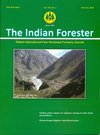Proximate Nutritional Composition of Acacia auriculiformis A. Cunn. Seeds
DOI:
https://doi.org/10.36808/if/2018/v144i2/122520Keywords:
Proximate Nutritional Value, Acacia auriculiformis, Seed, Food.Abstract
Proximate nutritional value of Acacia auriculiformis seeds for their protein, total carbohydrate, oil content and energy value was estimated aiming at its utilization to meet the requirement of daily food needs of tribal and local people during food scarcity. It was found that A. auriculiformis seeds have protein 8.47 ±0.98%, total carbohydrate 39.98±4.33%, lipids 8.12±0.41% and total energy kcal/100g 346.90 ±7.51suggesting their suitability to use as an alternative source to traditional staple food especially for marginalized tribal populations with a limited access to conventional cereals and pulses.References
Abd El-Moniem G.M. (1999). Sensory evaluation and in vitro protein digestibility of mung bean as affected by cooking time, J. Science of Food and Agriculture, 79:2025-2028.
Adewusi S.R.A., Falade O.S. and Harwood C. (2003). Chemical composition of Acacia colei and Acacia tumida seeds - Potential food sources in the semi-arid tropics, Food Chemistry, 80:187-195.
Brand J. and Maggiore P. (1991). The nutritional composition of Australian Acacia seeds. In: Proceeding: Workshop of Australian dry zone Acacias for human food, Glen Helen. 7-10 August 199. CSIRO Publications, Australia.
Chowdhury A.R., Banerji R., Misra G. and Nigam S.K. (1983). Chemical composition of Acacia seeds, J. Am. Oil Chem. Soc., 60(11):1893–1894.
Das D.K. and Alam M.K. (2001). Trees of Bangladesh, Bangladesh. Forest Research Institute (BFRI), Chittagong, Bangladesh.
Directorate of Economics and Statistics (2015). Agricultural statistics at glance 2015 (e-book), Ministry of Agriculture and Farmer Welfare, Govt. of India. 306-307.
Dubois M.K.A., Gilles J.K., Hamilton P.A., Rebers and F.S. ITH. (1956). Calorimetric method for determination of sugars and related substances, Anal. Chem., 28:350- 356.
El-Adawy T.A., Rahma E.H., El-Bedawy A.A. and Sobihah T.Y. (2000). Effect of soaking process on nutritional quality and protein solubility of some legume seed. Die Nahrung, 44:339-343.
Frazier W.C. and Westhoff D.C. (2007). Food Microbiology (IV Ed.). Tata McGraw-hill Publishing Company Limited, New Delhi.
Ghosh M., SinhaBabu S.P. and Sukul N.C. (1993). Antifilarial effect of two triterpenoid saponins isolated from Acacia auriculiformis, Indian J. Experimental Biology, 31:604-606.
Gopalan C., Ramashastri B.V. and Balsubramanian S.C. (1971). Nutritive value of Indian foods. National Institute of Nutrition, ICMR, Hyderabad, 156.
Gopalan C., Ramashastri B.U. and Balasubramaniam S.C. (1999). Nutritive value of Indian foods. NIN, ICMR, Hyderabad: 48.
Planning Commission India (2006). Report of the Working Group for the Eleventh Five Year Plan (2007-12) on Crop Husbandry, Agricultural Inputs, Demand and Supply Projections and Agricultural Statistics. New Delhi.
Iqbal A., Khalil I.A., Ateeq N. and Khan M.S. (2006). Nutritional quality of important food legumes, Food Chemistry, 97:331-335.
Khattab R.Y., Arntfield S.D. and Nyachoti C.M. (2009). Nutritional quality of legume seeds as affected by some physical treatments, Part 1: Protein quality evaluation, LWT - Food Science and Technology, 42:1107-1112.
Kumaraguru K.P. and Rajkumar M. (2010). Beneficial influences of germination and subsequent autoclaving of grain legumes on proximate composition, antinutritional factors and apparent digestibility in black tiger shrimp, Penaeus monodon Fabricius, Aquaculture Nutrition, 17: 188-195.
Mandal P., Sinhababu S.P. and Mandal N.C. (2005). Antimicrobial activity of saponins from Acacia auriculiformis. Fitoterapia, 76(5):462-465.
Pakrashi A., Ray H., Pal B.C. and Mahato S.B. (1991). Sperm immobilizing effect of triterpene saponins from Acacia auriculiformis, Contraception, 43:475–483.
Pal D., Chakraborty P., Ray H.N., Pal B.C., Mitra D. and Kabir S.N. (2009). Acaciaside-B-enriched fraction of Acacia auriculiformis is a prospective spermicide with no mutagenic property, Reproduction, 138:453–462.
Pimentel D. and Pimentel M. (2003). Sustainability of meat-based and plant-based diets and the environment, American J. Clinical Nutrition, 78:660–663.
Prakash D. and Mishra P.S. (1987). Protein and amino acid composition of some wild leguminous seed. Plant Food for Human Nutrition, 37: 29-32.
Sadasivam S. and Manickam A. (2008). Biochemical methods. New Age International (P) Limited, New Delhi, India.
Sahu S. (2012). Poverty, Food Security and State Entitlement in Jharkhand: A Case Study of Savar Community in East Singhbhum, Jharkhand J. Social Development, 4(1& 2):120-126.
Sathya A. and Siddhuraju P. (2013). Effect of Indigenous Processing Methods on Phenolics and Antioxidant Potential of Underutilized Legumes Acacia auriculiformis and Parkia roxburghii. J. of Food Quality, 36:98–112.
Sawhney S.K. and Singh R. (1999). Introductory Practical Biochemistry. Narosa Publication, New Delhi, India.
Seal T. and Chaudhuri K. (2016). Nutritional analysis of some selected wild edible plants consumed by the tribal people of Meghalaya state in India, Inter. J. Food Science and Nutrition, 1(6):39-43.
Seigler D.S. (2003). Phytochemistry of Acacia – Sensolato, Biochem. Syst. Ecol., 31:845–873.
Siddhuraju P., Becker K. and Makkar H.P.S. (2000). Studies on the nutritional composition and antinutritional factors of three different germplasm seed materials of an under-utilized tropical legume, Mucuna pruriens Var. Utilis, J. Agri. and Food Chemistry, 48:60486060.
Siddhuraju P., Vijayakumari K., Janardhanan K. (1996b). Chemical composition and protein quality of the little-known legume, velvet bean (Mucuna pruriens (L.) DC.), J. Agri. and Food Chemistry, 44:2636-2641.
Simons A.J. and Leakey R.R.B. (2004). Tree domestication in tropical agroforestry, Agrofor. Syst., 61:167–181.
Singh R., Singh S., Kumar S. and Arora S. (2007a). Free radical scavenging activity of acetone extract/fractions of Acacia auriculiformis A. Cunn. Food Chemistry, 103:1403-1410.
Singh R., Singh S., Kumar S. and Arora S. (2007b). Studies on antioxidant potential of methanol extract/fractions of Acacia auriculiformis A. Cunn, Food Chemistry, 103:505-511.
Singh R., Singh S., Kumar S. and Arora S. (2007c). Evaluation of antioxidant potential of ethyl acetate extract/fractions of Acacia auriculiformis A. Cunn, Food and Chemical Toxicology, 45:1216-1223.
The Wealth of India (1984). Vol. I CSIR, Publication New Delhi, 4-5.
Thimmaiah S.K. (2004). Standard Method of Biochemical Analysis. Kalayani Publisher, India.
Verma K.S., Pandey R. and Ayachi A. (2014). Nutritional assessment of different parts of Acacia catechu willd. collected from Central India, Inter. J. Pharm. Science and Research, 5(7):2980-2986.
Downloads
Downloads
Published
How to Cite
Issue
Section
License
Unless otherwise stated, copyright or similar rights in all materials presented on the site, including graphical images, are owned by Indian Forester.





